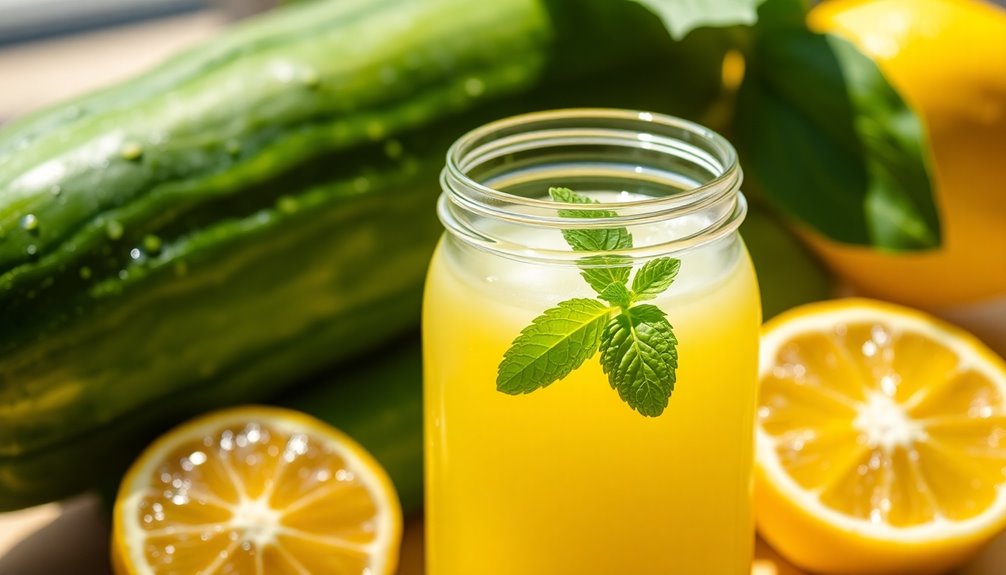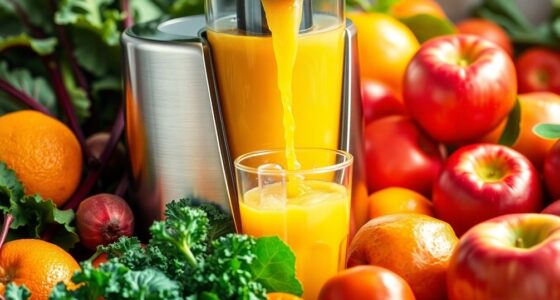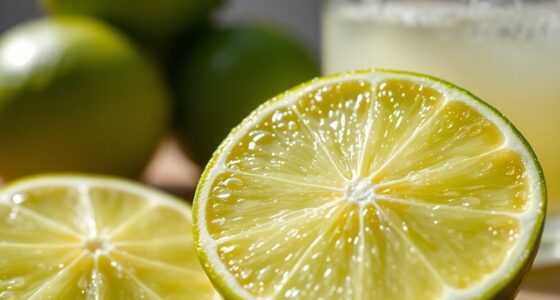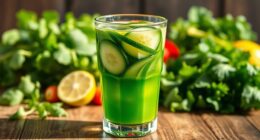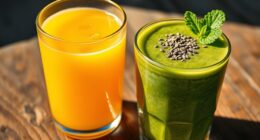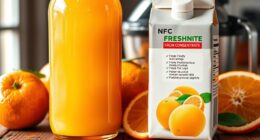To make refreshing lemon cucumber juice, slice two English cucumbers and blend them with six cups of water until smooth. Strain the mixture for a silky juice. Squeeze about one cup of lemon juice from seven to eight lemons, removing any seeds. Mix the cucumber and lemon juices, adjusting sweetness with sugar or agave. Stir in two tablespoons of chopped fresh mint for extra flavor. Pour over ice and garnish with cucumber and lemon slices. There’s more to explore about this delightful drink! You can also experiment by adding a pinch of salt or even a splash of soda water for some fizz. For those interested in enhancing their culinary skills, learning how to prepare pickle juice can open up new avenues for flavoring various dishes or making creative cocktails. This refreshing lemon cucumber juice not only quenches your thirst on a hot day but also serves as a fantastic base for exciting mixology adventures!
Key Takeaways
- Blend sliced cucumbers with six cups of water until smooth, then strain for silky cucumber juice.
- Squeeze about one cup of fresh lemon juice from seven to eight lemons, ensuring no seeds remain.
- Combine cucumber juice and lemon juice in a pitcher, adjusting sweetness with sugar or agave syrup as desired.
- Stir in two tablespoons of chopped fresh mint leaves to enhance flavor and aroma.
- Serve over ice, garnished with cucumber and lemon slices for an inviting presentation.
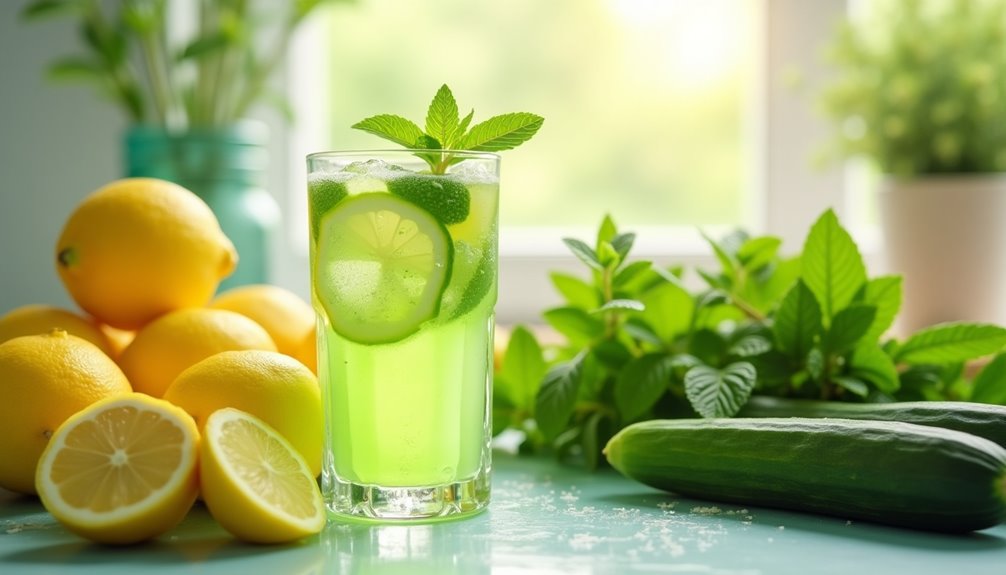
If you're craving a refreshing drink that combines the crispness of cucumbers with the tangy zest of lemons, making lemon cucumber juice is a great choice. This homemade cucumber juice not only tastes delightful, but it also packs some impressive nutritional benefits. It's easy to make, and you'll love how quickly you can whip it up to quench your thirst on a hot day.
To start, gather your ingredients. You'll need two English cucumbers, about seven to eight lemons for fresh lemon juice, water, sugar (or agave syrup if you prefer), and fresh mint leaves. The combination of these ingredients will give you a flavor profile that's both invigorating and satisfying.
Begin by preparing your cucumbers. Slice them up and toss them into your blender with six cups of water. Blend until the mixture is smooth. This step is crucial as it breaks down the cucumber, allowing you to extract all that refreshing juice.
Next, you'll want to strain the blended mixture through a fine mesh sieve. This will separate the juice from the cucumber pulp, leaving you with a silky, smooth cucumber juice. The vibrant green liquid that you see isn't just refreshing; it's packed with hydration and nutrients that are great for your skin and overall health.
Once you've got your homemade cucumber juice ready, it's time to add that tangy lemon juice. Squeeze approximately one cup of lemon juice from your lemons. When squeezing, make sure to remove any seeds that might sneak in. This zesty lemon juice will elevate the flavor of your drink, creating a perfect balance between the coolness of the cucumber and the brightness of the lemons.
Combine the cucumber juice and lemon juice in a pitcher, and taste it. Depending on your preference, you can adjust the sweetness by adding sugar or agave syrup. Keep in mind that freshly squeezed juices retain more nutrients than processed juice.
For an extra layer of freshness, chop up two tablespoons of fresh mint leaves and stir them into the mixture. The mint adds a delightful aroma and flavor that complements the cucumber and lemon beautifully.
Once everything is combined, it's time to serve. Pour the lemon cucumber juice over ice in your favorite glasses. To make it visually appealing, consider garnishing with slices of cucumber and lemon on the rim. This not only enhances the presentation but also adds a little extra flavor as you sip.
Now, you're all set to enjoy your homemade lemon cucumber juice. It's a refreshing drink that's perfect for warm days or any time you need a tasty and nutritious boost. You'll love how easy it's to make, and the combination of flavors will surely impress your friends and family. Cheers to a refreshing and delightful homemade beverage!
Frequently Asked Questions
What Is Cucumber and Lemon Juice Good For?
Cucumber and lemon juice is great for hydration, keeping your body refreshed and balanced.
You'll benefit from the high vitamin C content, boosting your immune system and enhancing your skin health.
It aids digestion by promoting enzyme production and supporting gut health.
Plus, the potassium helps regulate blood pressure, promoting cardiovascular health.
Lastly, the citric acid in lemon juice can help prevent kidney stones by increasing urine volume and reducing calcium concentration.
How Long Can You Keep Lemon Cucumber Water?
Imagine you've prepared a refreshing pitcher of lemon cucumber water for a summer gathering.
You can keep it in the refrigerator for up to 24 hours without losing much flavor or nutrients. However, it's best to enjoy it fresh.
If you let it sit out, drink it within 2 hours to prevent bacteria.
For long-term storage, freeze it in ice cube trays; it'll last up to a year if sealed properly.
Do You Peel Cucumbers When Juicing?
When you're juicing cucumbers, whether to peel them or not really depends on your preferences.
If your cucumbers aren't organic, you might want to peel them to avoid pesticide residues. On the other hand, if you're using English cucumbers, their thinner skin is often fine to leave on.
Remember, the skin adds nutrients and fiber, but peeling can give you a milder flavor.
Ultimately, it's all about what you enjoy most!
What Does Lemon and Cucumber Water Do for Your Skin?
Imagine your skin as a canvas, yearning for the vibrant strokes of health. When you sip lemon cucumber water, you invite antioxidants and vitamin C to rejuvenate your complexion.
The hydration from cucumber quenches your skin's thirst, combating dryness and fine lines. Meanwhile, lemon's citric acid gently exfoliates, brightening your tone and fading dark spots.
With regular enjoyment, you're not just drinking; you're nourishing your skin from the inside out, promoting clarity and radiance.
Conclusion
Now that you know how to whip up some refreshing lemon cucumber juice, it's time to enjoy your creation! Picture yourself lounging by the pool like it's the summer of '99, sipping on this zesty drink that's as cool as it gets. You've got the perfect blend of flavors to quench your thirst and impress your friends. So, grab a glass, relax, and toast to good vibes and great taste—cheers to your homemade refreshment!
Cindy thoroughly researches juicing trends, techniques, and recipes to provide readers with practical advice and inspiration. Her writing style is accessible, engaging, and designed to make complex concepts easy to understand. Cindy’s dedication to promoting the advantages of juicing shines through her work, empowering readers to make positive changes in their lives through the simple act of juicing.

